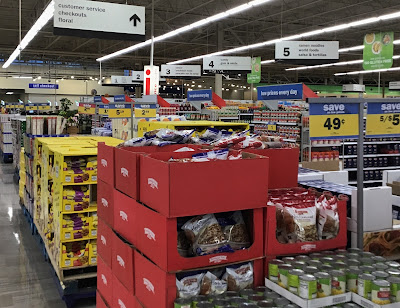 |
| Monday after 2021 Christmas on Saturday - so much in stock |
With so much space occupied, so much color, so much quantity of any given item in the grocery inventory, the general impression is one of abundance. If this is a feast for the eyes, then the visual effect can quickly lead to indigestion: Too Much Inventory. Projecting the full life-cycle of a foodstuff: it goes from source (field, ocean) to manufacture or processing and packaging and palletizing. Then truckers go from factory to depot distribution site before local delivery vehicles stock the retail level shelves. Once the consumer selects things for the shopping cart and either whiles away the time at checkout lane by browsing magazines and impulse purchases of candy and savory snacks, or else lines up for a turn at the self-checkout corral with one or two staff ready to trouble-shoot some of the scanning problems (alcohol sales requiring ID verification, mislabel/prices item, coupons not valid or not machine readable, double-counting of an item incorrectly swiped across the laser field, etc). Then, once consumed in whole or in part, the package is discarded and hauled away for solid waste (landfill) deposit, or sometimes it goes into the single-stream recycle curbside service in the city or town or countryside. In other words, looking back at this photo of such masses of products concentrated here, eventually each packet of chocolate chips will end up in a household within a 5 or 10-mile radius, then all these bags -once emptied- will end up during these next weeks and months scattered through the stream of solid waste carted away to the towering landfill ziggurat.
In summary, the scale and diversity of grocery (and department store) inventory today is astounding. Carts are scaled accordingly (the reverse of portion control: go big to encourage more buying). First-time shoppers can be intimidated as they gawk and wonder at the choices and the packaging volumes. Even long-time shoppers can sometimes express a slightly weary look, knowing how many steps their personal exercise calculator will record between arrival and checkout and exiting into the sea of cars filling the parking lot. Perhaps this kind of supply chain, display method, and business transaction is here to stay, forcing out of business almost all except the biggest regional and national stores.
No comments:
Post a Comment